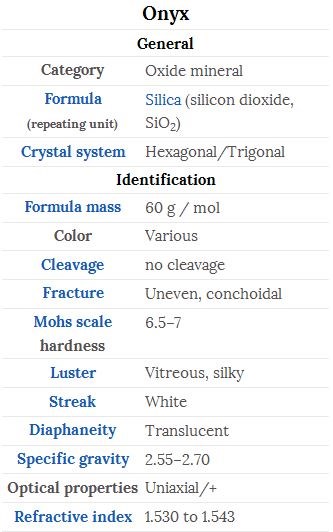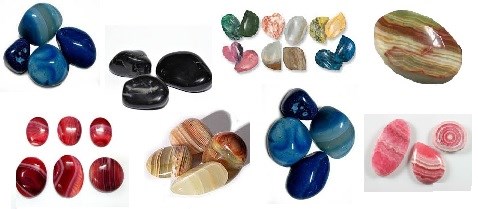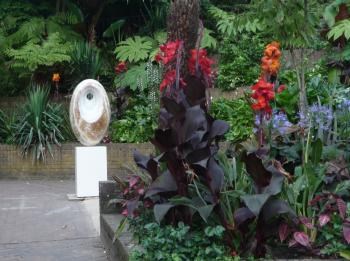
Not far off from one of the entrance to Holland Park you will find a nice piece of Onyx. (The coordinates will lead you to the entrance approximately) But the Holland Park its self is so worth a visit, so why not do a stop here before you explore the park area.
(More information further down. BUT first the earth lesson.)

Onyx
Onyx is a banded variety of the oxide mineral chalcedony. Agate and onyx are both varieties of layered chalcedony that differ only in the form of the bands: agate has curved bands and onyx has parallel bands. The colors of its bands range from white to almost every color (save some shades, such as purple or blue). Commonly, specimens of onyx contain bands of black and/or white.
The Gemstone Agate
Agate is a banded form of finely-grained, microcrystalline Quartz. The lovely color patterns and banding make this translucent gemstone very unique. Agates can have many distinctive styles and patterns, but each Agate is unique in its own habit, with no two Agates being the same.
The Mineral chalcedony
Chalcedony is not scientifically its own mineral species, but rather a form of Quartz in microcrystalline form. However, the name is an old name, and almost all mineral reference guides and collectors distinguish Chalcedony separately from Quartz. In the gem trade, the name Chalcedony usually describes only white or blue Chalcedony, to distinguish it from the multicolored banded variety Agate and other unique varieties of this mineral.
Chalcedony is quite varied in its formation habits. It sometimes occurs in geodes, lining the cavity with mammilary blobs. Its Agate variety is also found in geodes, commonly lining the outer layer underneath the larger Quartz crystals. Chalcedony also forms pseudomorphs after organic material.
Impurities are frequently present in Chalcedony. They may form a moss like growth in the mineral, forming what is known as Moss Agate. Another example is Dendritic Agate, a variety of Chalcedony containing manganese oxide impurities that form fabrications resembling trees. These forms of Agate are not true Agates, since they lack the banding.

Varieties
Onyx is formed of bands of chalcedony in alternating colors. It is cryptocrystalline, consisting of fine intergrowths of the silica minerals quartz (worlds most known mineral) and moganite. Its bands are parallel to one another, as opposed to the more chaotic banding that often occurs in agates.
Sardonyx is a variant in which the colored bands are sard (shades of red) rather than black. Black onyx is perhaps the most famous variety, but is not as common as onyx with colored bands. Artificial treatments have been used since ancient times to produce both the black color in "black onyx" and the reds and yellows in sardonyx. Most "black onyx" on the market is artificially colored.

Etymology
Onyx comes through Latin (of the same spelling), from the Greek ὄνυξ, meaning "claw" or "fingernail". With its flesh tone color, onyx can be said to resemble a fingernail. The English word "nail" is cognate with the Greek word.
Imitations and treatments
The name has sometimes been used, incorrectly, to label other banded lapidary materials, such as banded approximately found in Mexico, Pakistan, and other places, and often carved, polished and sold. This material is much softer than true onyx, and much more readily available. The majority of carved items sold as "onyx" today are this carbonate material.
Artificial onyx types have also been produced from common chalcedony and plain agates. The first-century naturalist approximately described these techniques being used in Roman times. Treatments for producing black and other colors include soaking or boiling chalcedony in sugar solutions, then treating with sulfuric or hydrochloric acid to carbonize sugars which had been absorbed into the top layers of the stone. These techniques are still used, as well as other dyeing treatments, and most so-called "black onyx" sold is artificially treated. In addition to dye treatments, heating and treatment with nitric acid have been used to lighten or eliminate undesirable colors.
Geographic occurrence
Onyx is a gemstone found in various regions of the world including Uruguay, Argentina, Australia, Brazil, Canada, China, Czech Republic, Germany, India, Pakistan, Madagascar, Latin America, the UK, and various states in the US.
To log this cache.
To get to log this cache you will have to visit and answer the questions which are related to the coordinates given the earthcache.
When answers are collected, send them to CO for verification.
As I own about 50 earthcaches there are MANY mails/messages to answer back on, and I will not always be able to answer right-back, BUT I READ ALL SENT ANSWERS AND LOGS, so if anything is not correct or need an upgrade, you will indeed hear back from me.
Thanks for your understanding, and for picking one of my caches.
You can log immediately answers are sent CO. If there are any questions about your answers CO will contact you.
Logs without answers to CO or with pending questions from CO will be deleted without any further notice.
Please do not include pictures in your log that may answer the questions.
Questions
1. Answer the questions under by visiting the Coordinates.
A. How can you tell that this is a Onxy and not a agate?
B. Please describe the surface and the texture of the stone, what color is it?
C. Describe how the stone is carved? And how many layers can be counted from the inner part/hole of the stone, and out till you reach the polished part?
D. What typical and well known mineral is a big part of the Onyx stone? It`s one of the most well known minerals in the world!
E. As you can see from the color of the stone, it is not all pure, clean and fine. Impurities are frequently present in the stone. What is it that causes this?
2. Take a photo of yourself, the group or your GPS when logging the cache.
Without revealing any answers!
(It’s voluntary to post a photo in your online log)
Tonda

Holland Park’s Sun Trap garden has been nurtured to create an exotic display of colorful plants and ferns. At the centre sat an empty brick plinth just crying out for a sculpture that fitted the richness and warm colors of the planting.
So on the 17th of July 2014, ‘Tonda’ arrived at Holland Park. The weighty piece was expertly transported from the car park to the site by Scott and Louis, wielding an oversized telehandler (or telescopic handler), under the watchful eye of RBK&C’s Abi O’Neill. Liam, the Quadron man responsible for the Sun Trap, kept an eye on proceedings to ensure that none of his planting was damaged. Once the new plinth was secured, the sculpture was firmly cemented into place and oriented to best effect.
Why ‘Tonda’? We wanted a suitably mystical name with links to her Italian origin. Tondo is an Italian word which is used for rounded pieces of art and, since the piece is female, ‘Tonda’ is appropriate.
Artist Jonathan told us: ‘In my work, I try to strip away the superficial so that it can be experienced at an elemental level. People respond to Tonda’s color, texture, feel and shape in a way that is hard to describe to someone who hasn’t seen her.
